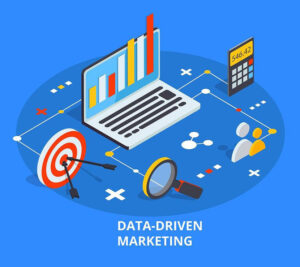
Using Data Driven Marketing to Improve Your Business
In the current digital era, companies are always seeking methods to enhance their marketing plans and boost performance. Data-driven marketing, which uses analytics to optimize marketing efforts and make wise judgments, is a new and very successful strategy. Businesses can better understand their target market, monitor the effectiveness of their marketing campaigns, and make successful decisions by using data-driven marketing. In this piece, we will examine the potential of data-driven marketing and how to apply it to improve outcomes.
What is Data Driven Marketing?
The process of using data and analytics to guide marketing initiatives, tactics, and decision-making is known as “data-driven marketing.” Businesses can obtain important insights into the behavior, tastes, and trends of their customers by utilizing data. With the use of this information, marketers can develop more audience-relevant, tailored ads that increase engagement, conversions, and return on investment.
The Role of Analytics
A key component of data-driven marketing is analytics. To derive valuable insights, it entails gathering, measuring, analysing, and interpreting data. With the use of analytics, marketers can evaluate the success of their campaigns, pinpoint areas in need of development, and optimize them using up-to-date information. organizations can improve results by tracking key  (KPIs), including website traffic, conversion rates, and customer engagement. These KPIs allow organizations to make data-driven decisions.
(KPIs), including website traffic, conversion rates, and customer engagement. These KPIs allow organizations to make data-driven decisions.
Benefits of Data-Driven Marketing
Improved Targeting
Businesses can obtain a comprehensive insight into their target audience through the analysis of consumer data. This enables marketers to design programs that are highly targeted and that speak to the needs, preferences, and habits of their target audience. Consequently, companies are able to reach the appropriate target with tailored communications, which raises conversion rates.
Enhanced Customer Insights
Consumer behaviour, preferences, and purchase trends can be better understood with the use of data-driven marketing. Businesses can use this information to better understand the customer journey and make well-informed decisions that will enhance the customer experience. Businesses can enhance client loyalty and foster stronger relationships by customizing marketing strategies based on customer insights.
Optimized Campaign Performance
Real-time tracking and measurement of marketing campaign performance is made possible by analytics for marketers. Through the tracking of key performance indicators (KPIs) like click-through rates, conversion rates, and client acquisition expenses, companies may pinpoint areas of underperformance and implement data-driven modifications to maximize campaign effectiveness. Higher ROI and more efficient use of resources result from this.
Cost Efficiency
Targeted and effective marketing campaigns are ensured by data-driven marketing, which does away with guessing. Businesses can efficiently manage their resources by concentrating on strategies and channels that produce the best outcomes by utilizing data and insights. This maximizes results, lowers expenses, and optimizes marketing budgets.
Competitive Advantage
Businesses that adopt data-driven marketing have a major advantage in today’s competitive world. Businesses can remain ahead of the curve, quickly adjust to changes in the market, and outperform rivals by leveraging data to drive decision-making. Businesses are empowered to make strategic, proactive decisions that propel growth and success through data-driven insights.
Leveraging Analytics for Better Results
Now that we are aware of the significance and advantages of data-driven marketing, let’s examine how companies may use this tactic to improve their performance. The following stages list the essential elements of an effective data-driven marketing strategy:
Define Goals and KPIs
Businesses must first specify their marketing objectives precisely and choose the key performance indicators (KPIs) that support them. Having specific objectives helps direct data collection and analysis activities, whether the objective is to improve customer interaction, increase website traffic, or increase conversions.
Collect and Organize Relevant Data
The next stage is to gather pertinent information from multiple sources, including social media platforms, customer databases, website analytics, and marketing automation technologies. Customer demographics, behaviour, interactions, and transaction history should all be included in this data. Easy access and analysis are ensured by organizing the data in a centralized system or data management platform.
Analyse and Interpret Data
After the data is gathered, it is critical to evaluate and understand the data in order to derive insightful knowledge. Machine learning algorithms, data visualization, and statistical methods can all be used in data analysis. Through the analysis of patterns, trends, and correlations found in the data, companies can derive practical insights that inform their marketing strategies.
Implement Personalization Strategies
A crucial component of data-driven marketing is personalization. By employing data analysis findings, companies can design customized marketing strategies that are aimed at particular client categories. Businesses may improve customer experiences and boost engagement by providing pertinent and tailored information.
Continuously Monitor and Optimize
The process of data-driven marketing is iterative. To find areas for improvement, it’s critical to regularly track campaign performance and important indicators. Through the utilization of real-time data, companies may improve campaigns, manage resources efficiently, and achieve superior outcomes by implementing data-driven modifications.
Embrace Marketing Automation
Platforms for marketing automation are essential to data-driven marketing. Businesses can use these technologies to assess campaign performance, segment audiences, tailor content, and automate repetitive operations. Businesses may increase productivity, save time, and streamline procedures by utilizing marketing automation.